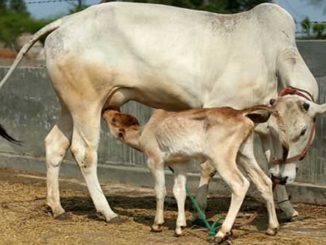Reproductive hormones induce heat (estrus) in cows. There is no production without reproduction. Hormone is a a chemical messenger that gets released from hypothalamus, pituitary gland, ovary, uterus, or placenta. Different hormones have different points of release. To understand functions of hormones in a dairy cow, let’s refresh how reproduction happens in dairy cow.
After every 21 days the ovary releases a mature ovum and the cow comes on heat. The ovum travels through the fallopian tubes to the uterus and waits for sperm to get mated. The release and movement of the ovum down to the uterus is called ovulation. If mating is done at this time, fertilization will take place and animal will get pregnant. The whole process of reproduction is governed by some chemical messengers which are termed as ‘Hormones’. Hormones are chemicals which travel through blood, they start their journey from their point of release/origin, travel through medium (blood) and reach their target site and produce desired effect.
In dairy farming, we manipulate reproduction through synthetic chemical messengers i.e hormone analogues which are administered to get desired effect artificially. First we should begin with different hormone types which are naturally produced in animal body, their functions and how we can use them to get desired effect.
Key Hormones that govern Reproduction
1. Gonadotropin Releasing Hormone (GnRH)
GnRH is also known as Mother Reproductive Hormone. It is released from the Anterior Hypothalamic Area (AHA) of hypothalamus.
Functions
- It induces the growth of follicles
- It causes the release of FSH and LH
- It induces the cyclicity in acyclic female animals
Clinical uses
- Synthetic GnRH is used in delayed estrus, true anestrus, low conception rate and estrus synchronization.
- It is used at the time of AI in delayed ovulators.
2. Follicle Stimulating Hormone (FSH)
FSH is also called folli-tropin. It is released form anterior pituitary.
Functions in Female
- It stimulates the growth of ovarian follicle.
- It enhances the estrogen (estardiol-E2) production from ovarian follicle.
- It also helps the formation of LH receptors on granulosa cells so that LH can perform its function.
Functions in Males
- It causes the growth of seminiferous tubules.
- It influence the spermatogenesis (up to formation of 2nd spermatocytes)
- It acts on the sertoli cells and stimulate them to produce Androgen Binding Protein (ABP).
3. Luteinizing Hormone (LH)
It is also called as leutropin. It is released from anterior pituitary.
Functions in Female:
- It has receptors on the theca cells & mature granulosa cells of the follicles, luteal cells of corpus luteum and interstitial cells.
- It causes maturation of ovarian follicles.
- It helps in ovulation.
- It helps in corpus luteum formation.
- It helps maintaining the corpus luteum.
Functions in Male:
- LH acts on Leydig cell for production of testosterone.
- It causes the stimulation of interstitial cells to produce androgen binding protein (ABP).
4. Prolactin (PRL)
It is released from the anterior pituitary.
Functions:
- It influences the metabolic growth in an individual.
- In Female, induces the milk synthesis.
- It induces the maternal behavior in animals for caring and nursing their offsprings.
- It induces suppressive effects on the secretions of gonadotrpoins.
5. Oxytocin
Oxytocin is released from hypothalamus. Oxytocin target is smooth muscles of reproductive tract.
Functions
- Required for delivery of fetus and helpful for expulsion of fetal membrane
- Causes the contraction of smooth muscles of certain organs (particularly of reproductive system).
- Helps in movement of the gametes to the sight of fertilization
- Plays important role for milk letdown. Teats have tactile receptors which send message to brain & from brain signal goes to hypothalamus to secrete Oxytocin. This Oxytocin through blood reaches to milk alveoli and then helps in contraction of myothelial cells; results into milk letdown.
- Stimulates the secretions of PGF2α and thus helpful for killing Carpus luteum
Uses
- Used in milk led down problem in animals
- Used when there is difficultly in parturition due to deficiency of uterine contraction
- Used to enhance the postpartum uterine involution
- Used for treating retention of fetal membrane cases within 24 hours after parturition.
- To improve the conception rate at the time of breeding
- Used in cases of uterine prolapse
6. Estrogens
Estrogens are steroid hormones and are responsible for the development and maintenance of secondary sex characteristics and for induction of estrus behavior and ovulation in female animals.
Types of Estrogens
Estron (E1), Estradiol (E2), Estriol (E3), Equilin, Equilinen are the major estrogens. Equilin and Equilinen are only found in equines.
The principal estrogen is Estrodiol (E2). The immediate precursors of estrogens are androgens (Testosterone). These are produced by glandular as well as non-Glandular tissues.
Functions
- Estrogens establish the femininity (femaleness of an individual).
- Promotes the fetal growth.
- Induces secondary sex characteristic as well as sexual behavior.
- Causes differentiation of neural tissue, so that there are functional differences in several areas of brain of female compared to that of male.
- After birth promotes the growth of female genital organs & at puberty rate of growth is blooming.
- Plays important role in the development of skeleton and to give a peculiar shape to the body contour.
- Plays important role in the formation or development of duct system in mammary glands and also causes fat deposition in mammary gland and other body areas.
- Induces estrous behavior in female animals or causes the expression of heat signs.
- Induces the release of preovulatory LH-surge in cyclic female animals.
Uses
- Used for prevention of unwanted or mismated pregnancy
- Used to cause abortion due to any medical reason.
- Used to treat the mild endometritis in ruminants.
- Used for dilatation of cervix, in certain cases of dystocia.
7. Progesterone
It is a 21 C atom steroid hormone which is responsible for maintaining pregnancy in all female animals. In females it is mainly secreted from C.L (G.F, placenta & adrenal gland also secrete small amount of progesterone). In males it is secreted from the testes. Since progesterone is changed into the testosterone, some unconverted progesterone comes in blood.
Functions
- It maintains the pregnancy.
- It primes the brain center for the action of estrogen for behavioral signs.
- It reduces (inhibits) the contractility of the uterus.
- It causes the closure of cervical rings and thickening of the cervical mucus.
- It stimulates growth of uterus during pregnancy.
- It prepares the uterus for implantation of the zygote.
- It stimulates the secretary activity of uterine glands.
- It suppresses the local immune mechanism of uterus because fetus is 50% foreign body.
- It forms the milk alveoli of the mammary glands.
- It plays important role in inducing maternal behavior.
- It has strong negative feedback effect on GnRH and gonadotropins.
Uses
- Used to stop the abortion in those animals where there is deficiency of Progesterone.
- It is used for the synchronization of estrus (Progesterone sponges are used)
Progesterone Sponges
- PRID (Progesterone releasing intravaginal device)
- CIDR (Controlled internal drug release)
- Androgens
Naturally occurring androgens are 19 carbon steroid hormone responsible for the maintenance and development of Masculine characteristics.
The main androgens are Testosterone, Androstenedion, Dihydroepiendrosteron (DHEA), 5-Androstenediol.
Testosterone is the important one. Testosterone is converted into 5α-dihydro-testosterone (5α-DHT) which is the metabolite of testosterone. This 5α-DHT is needed by prostate gland, penis and scrotum; is more common in humans and dogs and less common in farm animals.
Functions
In Fetus
- It differentiates the brain during fetal development especially hypothalamus and spinal cord.
- It stimulates differentiation of Wolffian duct (male tubular genetalia will develop from it).
At Puberty
- Testosterone causes pubertal growth of male genital organs including the accessory sex organs.
- It causes hypertrophy of vocal cords (voice of male changes at puberty).
- Hair growth at certain areas.
- Stimulates growth of skeletal muscles especially shoulders.
- It enhances spermatogenesis (especially maturation of sperm).
- It stimulates secretary activity and growth of accessory sex glands.
In Adults
- It maintains the pregnancy.
- It maintains the secretary activity of accessory sex glands.
- It favors the baldness.
- It maintains the libido (sexual desire).
- It favors the RBC synthesis i.e. males have 10-15% more RBCs
Uses
- It is used to androgenize the infertile cows so that they have the male characteristics and with the help of them heat detection of other animals could be made possible.
- It is used to descend the testes in scrotum if not descended.
- It is used to improve the debilitating effect of costly animals.
- Certain androgens have been developed which have more anabolic effect than sexual effect.
9. Prosaglandins (PGs)
PGs are hormone like chemicals occurring naturally in all mammals. These are not secreted by the glands but are secreted by the cells scattered throughout the body.
These are derivatives of fatty acids, mainly arachidonic acid. Arachindonic acid is a 20 Carbon polyunsaturated essential fatty acid that has cyclopentane ring in its structure. Prostaglandins are not stored in the cell, but when physical or chemical or hormonal stimuli come, they are secreted in many body parts. PGs are involved in inflammatory processes, gastric secretion, respiratory system, blood clotting and also perform important reproductive functions. PGA, PGB, PGE, PGF are different kinds of PGs. They perform different function in the different species.
Functions
- Act as the leuteotropic hormone.
- Cause strong contraction of smooth muscles of reproductive tract.
- PGF2α is the most important PG in female because it determines the length of estrus cycle. In females PGF2α is secreted by the endometrium, myometrium, fetoplacental unit (placentome), and graffian follicle.
- PGF2α regresses the C.L. We can shorten the estrus cycle length by intravenous administration of PGF2α which kills the corpus luteum. PGF2α does not come in the general circulation. PGFM is the metabolite of PGF2α which comes in general circulation.
- Myometrial cells in graffian follicle are also contracted by PGF2α.
Uses
- It is clinically used to terminate the pregnancy.
- Used for synchronization of heat (squeeze the estrus cycle length)
- After parturition used for removal of pathological contents from the uterus (in case of pyometra and mummified fetus)
| The content of the articles are accurate and true to the best of the author’s knowledge. It is not meant to substitute for diagnosis, prognosis, treatment, prescription, or formal and individualized advice from a veterinary medical professional. Animals exhibiting signs and symptoms of distress should be seen by a veterinarian immediately. |







1 Trackback / Pingback